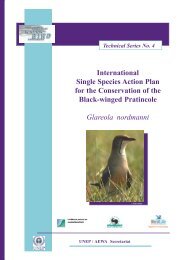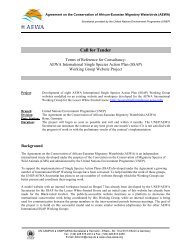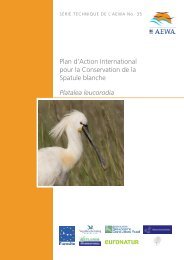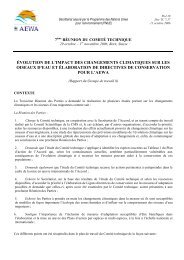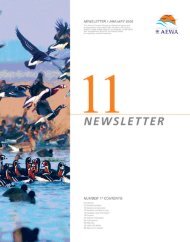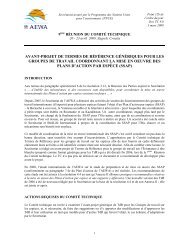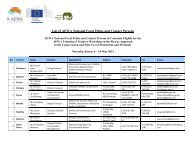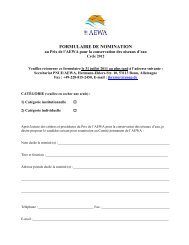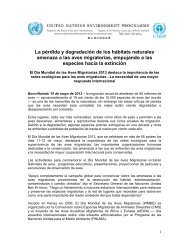Lesser White-fronted Goose Field Guide - WWF
Lesser White-fronted Goose Field Guide - WWF
Lesser White-fronted Goose Field Guide - WWF
Create successful ePaper yourself
Turn your PDF publications into a flip-book with our unique Google optimized e-Paper software.
© Seppo Ekelund<br />
<strong>Lesser</strong> <strong>White</strong>-<strong>fronted</strong> <strong>Goose</strong> <strong>Field</strong> <strong>Guide</strong><br />
Identification and Monitoring of a Globally Threatened Species<br />
The globally threatened <strong>Lesser</strong> <strong>White</strong>-<strong>fronted</strong> <strong>Goose</strong> (Anser erythropus) is a migratory species<br />
which occurs regularly in the following countries: Azerbaijan, Bulgaria, China, Estonia, Finland,<br />
Germany, Greece, Hungary, Iran, Iraq, Kazakhstan, Lithuania, the Netherlands, Norway,<br />
Poland, Romania, Russia, Sweden, Syria, Turkey, Turkmenistan, Ukraine and Uzbekistan.<br />
The conservation of the <strong>Lesser</strong> <strong>White</strong>-<strong>fronted</strong> <strong>Goose</strong> is particularly challenging due to the<br />
fact that it looks very similar to its close relative the Greater <strong>White</strong>-<strong>fronted</strong> <strong>Goose</strong> (Anser<br />
albifrons), which is a common species open for hunting. During the non-breeding period the<br />
two species are often found together in mixed flocks, making it difficult to tell them apart -<br />
even for experienced ornithologists.<br />
Many range states and dedicated stakeholders are already working together to protect the<br />
<strong>Lesser</strong> <strong>White</strong>-<strong>fronted</strong> <strong>Goose</strong>. However, much information on the species is still missing and<br />
therefore your help is needed to save this charismatic bird.
The Challenge: Correctly Identifying <strong>Lesser</strong> <strong>White</strong>-<strong>fronted</strong> Geese<br />
Adult <strong>Lesser</strong> <strong>White</strong>-<strong>fronted</strong> <strong>Goose</strong> and adult Greater <strong>White</strong>-<strong>fronted</strong> <strong>Goose</strong> © Jari Kostet<br />
<strong>Lesser</strong> <strong>White</strong>-<strong>fronted</strong> <strong>Goose</strong><br />
Greater <strong>White</strong>-<strong>fronted</strong> <strong>Goose</strong><br />
Head<br />
colour<br />
Head and upper two thirds of neck are<br />
uniformly dark brown – distinctly darker<br />
than the Greater <strong>White</strong>-<strong>fronted</strong> <strong>Goose</strong>.<br />
Only narrow zone at the rear margin of the<br />
white blaze is dark brown – clear contrast<br />
with light brown head and neck.<br />
Head Smaller, neater, more rounded head Larger, slimmer head.<br />
shape (“boxy” shape) with steeper forehead.<br />
Neck Distinctly shorter and thicker. Longer, slimmer and lighter in colour.<br />
Eye-ring Prominent bright yellow eye-ring. Either no eye-ring or thin dull yellow eyering.<br />
Bill Short, stubby triangular bill – bright pink. Longer, slimmer bill - duller pink in colour.<br />
Blaze <strong>White</strong> blaze reaches far up on the crown. Relatively smaller white blaze.<br />
Size Smaller in size. Larger in size.<br />
Call Clear and whistling “tu-yu(-yu)” voice –<br />
lacks sharp “click-click-click-click” call<br />
of the Greater <strong>White</strong>-<strong>fronted</strong> <strong>Goose</strong>.<br />
The call corresponding to the “tu-yu(-yu)” of<br />
the <strong>Lesser</strong> <strong>White</strong>-<strong>fronted</strong> <strong>Goose</strong> is raspier –<br />
also makes a sharp “click-click-click-click”<br />
call.<br />
• In a flock on the ground, a good indication is the small size, overall darkness and<br />
more upright posture of <strong>Lesser</strong> <strong>White</strong>-<strong>fronted</strong> Geese.<br />
• In flight, the smaller size combined with the shorter neck and bill, darker head and<br />
somewhat narrower wings are the best characteristics for identification.<br />
• Juveniles are particularly hard to identify! Try to locate the family group as families<br />
typically migrate together and identify the species of the juvenile by identifying the<br />
parents.<br />
For more detailed identification instructions, please see: Øien, I.J., Tolvanen, P., Aarvak, T. & Markkola, J. 1999:<br />
Occurrence and identification of <strong>Lesser</strong> <strong>White</strong>-<strong>fronted</strong> <strong>Goose</strong>. – Alula 5:18-23. Available on: www.piskulka.net.
Collecting Vital Information: Monitoring of <strong>Lesser</strong> <strong>White</strong>-<strong>fronted</strong> Geese<br />
Adult <strong>Lesser</strong> <strong>White</strong>-<strong>fronted</strong> <strong>Goose</strong> (second individual from below) in a flock of Greater <strong>White</strong>-<strong>fronted</strong> Geese. © Jari Kostet<br />
When observing <strong>Lesser</strong> <strong>White</strong>-<strong>fronted</strong> Geese, please note down the most important information:<br />
Count - or estimate - the number of <strong>Lesser</strong> <strong>White</strong>-<strong>fronted</strong> Geese (also assess the total number of<br />
all geese present and the percentage of <strong>Lesser</strong> <strong>White</strong>-<strong>fronted</strong> Geese in the flocks).<br />
Check for possible colour rings, neck bands and satellite transmitters (write down any colours<br />
or numbers you can identify).<br />
Identify the feeding and roosting sites being used by the <strong>Lesser</strong> <strong>White</strong>-<strong>fronted</strong> Geese (note the<br />
exact locations and habitat types being used and take photos).<br />
Estimate the hunting pressure (assess whether hunting is heavy in the area used by the geese by<br />
counting shots per minute and by observing hunters moving in the area - request hunters to show<br />
you birds they have shot and take photos).<br />
NOTE: Distinguishing between <strong>Lesser</strong> <strong>White</strong>-<strong>fronted</strong> and Greater <strong>White</strong>-<strong>fronted</strong> Geese<br />
requires good conditions in the field and good identification skills. Identification should never<br />
be based on one characteristic alone: for example, at close range the yellow eye-ring can be<br />
surprisingly clear also in Greater <strong>White</strong>-<strong>fronted</strong> Geese, whilst on the other hand the eye-ring<br />
of the <strong>Lesser</strong> <strong>White</strong>-<strong>fronted</strong> <strong>Goose</strong> is not visible at a long distance. If you are not 100% sure<br />
about your sighting, please report seeing unidentified <strong>White</strong>-<strong>fronted</strong> Geese. In addition, try<br />
to take a photograph for possible later identification.<br />
More detailed monitoring instructions can be found on the website of the EU LIFE+ project “Safeguarding<br />
the <strong>Lesser</strong> <strong>White</strong>-<strong>fronted</strong> <strong>Goose</strong> along its European Flyways” hosted by <strong>WWF</strong> Finland: http://wwf.fi/lwfg/
Much is still unknown about the <strong>Lesser</strong><br />
<strong>White</strong>-<strong>fronted</strong> <strong>Goose</strong> - particularly<br />
concerning its migration routes and<br />
wintering areas. In order to gather more<br />
information, an online reporting template<br />
for the <strong>Lesser</strong> <strong>White</strong>-<strong>fronted</strong> <strong>Goose</strong> has<br />
been established on the website hosted by<br />
the Fennoscandian <strong>Lesser</strong> <strong>White</strong>-<strong>fronted</strong><br />
<strong>Goose</strong> Project:<br />
www.piskulka.net<br />
Please report any sightings of <strong>Lesser</strong><br />
<strong>White</strong>-<strong>fronted</strong> Geese on this website or<br />
send an email directly to Tomas Aarvak<br />
at the Norwegian Ornithological Society<br />
(tomas@birdlife.no). All information is<br />
valuable - including information about<br />
dead or accidentally shot birds.<br />
Adult Greater <strong>White</strong>-<strong>fronted</strong> <strong>Goose</strong> (above) and adult <strong>Lesser</strong><br />
<strong>White</strong>-<strong>fronted</strong> <strong>Goose</strong> © Jari Kostet<br />
If possible, please include photographs of<br />
the birds you have seen. You can also send<br />
us information in other languages - such as<br />
Russian or Arabic – and we will arrange for<br />
it to be translated.<br />
For more information on the species as well as current conservation efforts, please visit the<br />
following websites:<br />
Portal for the <strong>Lesser</strong> <strong>White</strong>-<strong>fronted</strong> <strong>Goose</strong>:<br />
EU LIFE+ project website hosted by <strong>WWF</strong> Finland:<br />
AEWA <strong>Lesser</strong> <strong>White</strong>-<strong>fronted</strong> <strong>Goose</strong><br />
International Working Group:<br />
www.piskulka.net<br />
http://wwf.fi/lwfg/<br />
http://lesserwhite<strong>fronted</strong>goose.aewa.info<br />
Thank you for helping to save the <strong>Lesser</strong> <strong>White</strong>-<strong>fronted</strong> <strong>Goose</strong>!<br />
This field guide was produced within the framework of the EU LIFE+ project “Safeguarding the <strong>Lesser</strong> <strong>White</strong>-<strong>fronted</strong><br />
<strong>Goose</strong> within the European Flyway” and was funded by the UNEP/AEWA Secretariat.



